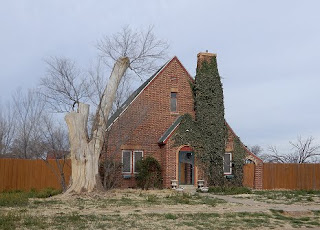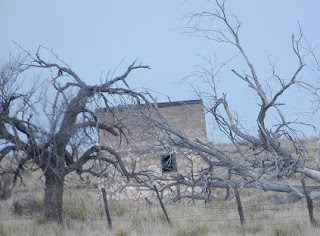As a kid I thought calling something the
‘panhandle’ of a state was funny.
Of course, Oklahoma looked a bit like a pot
with a handle, but Florida didn’t fit that image, and neither did Texas. Adults
had odd ways of naming things, and this was one of their idiosyncrasies. Dave
and I have driven through the Texas Panhandle lots of times, but we’ve never
stopped in Parmer County and in particular Farwell. We can’t say that now.
Parmer County is a county located on the high plains of the Llano Estacado. It was originally the hunting grounds of the Apaches, but they were forced out by the Comanches and Kiowas in the late 18th century. In 1876 the Texas legislature established Parmer County from lands
formerly assigned to the Bexar District. The county was named for Martin Parmer, a Texas Revolutionary war
veteran. No settlement occurred in the county until 1882, but once the Anglos
wanted to move in, the Native Americans were removed by the U.S. Army. Parmer
County was actually entirely within the lands granted to the Chicago syndicate
for the XIT Ranch in 1880.
Until 1900 the entire county was only populated by XIT cowboys. The big change
began in 1898 with the coming of the Pecos and Northern
Texas Railway Company as it constructed its line from Amarillo to the Texas-New
Mexico border. The county was finally organized in 1907.
The little town of Farwell began as a cow-camp for the XIT Ranch. The
XIT Ranch came about because two brothers
named Farwell from Lake Forest, Illinois built the Texas state
capital in exchange for 3.050,000 acres of virgin ranchland. This ranch
employed 800 cowboys to build a 6,000 mile barbed wire fence to keep cattle
rustlers from stealing from the herds. The first courthouse was built in 1907
at Parmerton and then moved to Friona; but the building burned. In that same
year an election was held to determine which of the small towns would be the
county seat. Because cowboys had no fixed address, the election was highly argued
as to where they would be allowed to cast their vote. It was finally decided
that residency was based on where the men did their laundry. At the time,
Farwell had the only laundry, and thus collected the most votes. The 1916 Parmer
County courthouse, designed by Architects Risser and Townes, is a three
story building of buff-colored brick and concrete in the Classical
Revival style. It sits less than 1,000 feet from the Texas-New Mexico state
line. Farwell sits at the junction of two branches of the Santa Fe Railway:
one toward Amarillo and the other toward Lubbock. When the XIT began selling
land to settlers, they would arrive on the train from either north or south;
they stayed in the Farwell Hotel and road in touring cars to see the available
homestead sites. Many others arrived in covered wagons. Some settlers became
dry-land farmers with small herds of cattle; they persevered through windstorms
and drought, making the High Plains their home.
The boundary between Texas and New Mexico was
supposed to be set at the 103rd meridian, however the 1859 surveyors
goofed. They marked the border between 2 ¼ and 3 ¾ miles too far west; this made
Farwell, Texline, and a section of Glenrio appear to be in Texas. The strip of
land, several hundred miles long, puts parts of the oilfields of the Permian
Basin in question as to who owns it: Texas or New Mexico. Eventually the courts
ruled that the land and towns are taxed and governed by Texas.
©2019 NearNormal Design and Production Studio - All rights including copyright of photographs and designs, as well as intellectual rights are reserved.
 |
| One of the older houses in Farwell |
Parmer County is a county located on the high plains of the Llano Estacado. It was originally the hunting grounds of the Apaches, but they were forced out by the Comanches and Kiowas in the late 18th century. In 1876 the Texas legislature established Parmer County from lands
 |
| An old brick building in Parmer Counter |
The little town of Farwell began as a cow-camp for the XIT Ranch. The
 |
| Parmer County courthouse |
 |
| New Mexico state line |
 |
| Cottontail rabbit in a small cemetery |
©2019 NearNormal Design and Production Studio - All rights including copyright of photographs and designs, as well as intellectual rights are reserved.
No comments:
Post a Comment